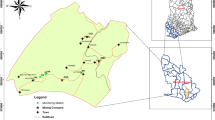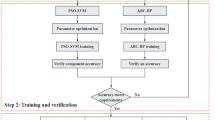Abstract
PM2.5 concentration is an important indicator to measure the concentration of air pollutants, and it is of important social significance and application value to realize accurate prediction of PM2.5 concentration. To further improve the accuracy of PM2.5 concentration prediction, this paper proposes a hybrid machine learning model (WD-SA-LSTM-BP model) based on simulated annealing (SA) optimization and wavelet decomposition. Firstly, the wavelet decomposition algorithm was used to realize the multiscale decomposition and single-branch reconstruction of PM2.5 concentrations to weaken the prediction error caused by time series data. Secondly, the SA optimization method was used to optimize the super-parameters of each machine learning model under each reconstructed component, so as to solve the problem that it is difficult to determine the parameters of machine learning model. Thirdly, the optimized machine learning model was used to predict the PM2.5 concentration, and the error value was calculated from the actual measured value. Then, the optimized machine learning model was used to predict the error value. Finally, the predicted error value was added to the predicted PM2.5 concentration to obtain the final predicted PM2.5 concentration. The study is experimentally validated based on daily PM2.5 data collected from Nanjing air quality monitoring stations. The experimental results showed that the RMSE and MAE values of the constructed WD-SA-LSTM-BP model were 5.26 and 3.72, respectively, which were superior to those of the WD-LSTM and LSTM models, indicating that the hybrid machine learning model based on SA optimization and wavelet decomposition could better predict the PM2.5 concentration.









Similar content being viewed by others
Data availability
The datasets used and/or analyzed during the current study are available from the corresponding author on reasonable request.
References
Abdoli B, Mirhassani SA, Hooshmand F (2017) Model and algorithm for bi-fuel vehicle routing problem to reduce GHG emissions. Environ Sci Pollut R 24(27):21610–21624. https://doi.org/10.1007/s11356-017-9740-8
Ahani IK, Salari M, Shadman A (2020) An ensemble multi-step-ahead forecasting system for fine particulate matter in urban areas. J Clean Prod 263:120983. https://doi.org/10.1016/j.jclepro.2020.120983
Anderson JO, Thundiyil JG, Stolbach A (2012) Clearing the air: a review of the effects of particulate matter air pollution on human health. J Med Toxicol 8(2):166–175. https://doi.org/10.1007/s13181-011-0203-1
Bento PMR, Pombo JAN, Calado MRA, Mariano SJPS (2019) Optimization of neural network with wavelet transform and improved data selection using bat algorithm for short-term load forecasting. Neurocomputing 358:53–71. https://doi.org/10.1016/j.neucom.2019.05.030
Calvello M, Caggiano R, Esposito F, Lettino A, Sabia S, Summa V, Pavese G (2017) IMAA (Integrated Measurements of Aerosol in Agri valley) campaign: Multi-instrumental observations at the largest European oil/gas pre-treatment plant area. Atmos Environ 169:297–306. https://doi.org/10.1016/j.atmosenv.2017.09.026
Chen Y (2018) Prediction algorithm of PM2.5 mass concentration based on adaptive BP neural network. Computing 100(8):825–838. https://doi.org/10.1007/s00607-018-0628-3
Chu J, Dong Y, Han X, Xie J, Xu X, Xie G (2021) Short-term prediction of urban PM2.5 based on a hybrid modified variational mode decomposition and support vector regression model. Environ Sci Pollut R 28(1):56–72. https://doi.org/10.1007/s11356-020-11065-8
Dennis RL, Byun DW, Novak JH, Galluppi KJ, Coats CJ, Vouk MA (1996) The next generation of integrated air quality modeling: EPA’s models-3. Atmos Environ 30(12):1925–1938. https://doi.org/10.1016/1352-2310(95)00174-3
Dhakal S, Gautam Y, Bhattarai A (2021) Exploring a deep LSTM neural network to forecast daily PM2.5 concentration using meteorological parameters in Kathmandu Valley. Nepal. Air Quality, Atmosphere & Health 14(1):83–96. https://doi.org/10.1007/s11869-020-00915-6
Eeftens M, Tsai M, Ampe C, Anwander B, Beelen R, Bellander T, Cesaroni G, Cirach M, Cyrys J, de Hoogh K, De Nazelle A, de Vocht F, Declercq C, Dėdelė A, Eriksen K, Galassi C, Gražulevičienė R, Grivas G, Heinrich J, Hoffmann B, Iakovides M, Ineichen A, Katsouyanni K, Korek M, Krämer U, Kuhlbusch T, Lanki T, Madsen C, Meliefste K, Mölter A, Mosler G, Nieuwenhuijsen M, Oldenwening M, Pennanen A, Probst-Hensch N, Quass U, Raaschou-Nielsen O, Ranzi A, Stephanou E, Sugiri D, Udvardy O, Vaskövi É, Weinmayr G, Brunekreef B, Hoek G (2012) Spatial variation of PM2.5, PM10, PM2.5 absorbance and PMcoarse concentrations between and within 20 European study areas and the relationship with NO2 – results of the ESCAPE project. Atmos Environ 62:303–317. https://doi.org/10.1016/j.atmosenv.2012.08.038
Elbayoumi M, Ramli NA, Yusof FF Md (2015) Development and comparison of regression models and feedforward backpropagation neural network models to predict seasonal indoor PM2.5–10 and PM2.5 concentrations in naturally ventilated schools. Atmos Pollut Res 6(6):1013–1023. https://doi.org/10.1016/j.apr.2015.09.001
Goyal P, Chan AT, Jaiswal N (2006) Statistical models for the prediction of respirable suspended particulate matter in urban cities. Atmos Environ 40(11):2068–2077. https://doi.org/10.1016/j.atmosenv.2005.11.041
Ibrir A, Kerchich Y, Hadidi N, Merabet H, Hentabli M (2021) Prediction of the concentrations of PM1, PM2.5, PM4, and PM10 by using the hybrid dragonfly-SVM algorithm. Air Quality, Atmosphere & Health 14(3):313–323. https://doi.org/10.1007/s11869-020-00936-1
Jian L, Zhao Y, Zhu Y, Zhang M, Bertolatti D (2012) An application of ARIMA model to predict submicron particle concentrations from meteorological factors at a busy roadside in Hangzhou, China. Sci Total Environ 426:336–345. https://doi.org/10.1016/j.scitotenv.2012.03.025
Kobza J, Geremek M, Dul L (2018) Characteristics of air quality and sources affecting high levels of PM10 and PM2.5 in Poland, Upper Silesia urban area. Environ Monit Assess 190(9):515. https://doi.org/10.1007/s10661-018-6797-x
Liu D, Sun K (2019) Short-term PM2.5 forecasting based on CEEMD-RF in five cities of China. Environ Sci Pollut R 26(32):32790–32803. https://doi.org/10.1007/s11356-019-06339-9
Pai T, Ho C, Chen S, Lo H, Sung P, Lin S, Lai W, Tseng S, Ciou S, Kuo J, Kao J (2011) Using seven types of GM (1, 1) model to forecast hourly particulate matter concentration in Banciao city of Taiwan. Water Air Soil Pollut 217(1):25–33. https://doi.org/10.1007/s11270-010-0564-0
Sanguineti PB, Lanzaco BL, López ML, Achad M, Palancar GG, Olcese LE, Toselli BM (2020) PM2.5 monitoring during a 10-year period: relation between elemental concentration and meteorological conditions. Environ Monit Assess 192(5):313. https://doi.org/10.1007/s10661-020-08288-0
Sfetsos A, Vlachogiannis D (2010) A new methodology development for the regulatory forecasting of PM10. Application in the Greater Athens Area. Greece. Atmos Environ 44(26):3159–3172. https://doi.org/10.1016/j.atmosenv.2010.05.028
Shi E, Shang Y, Li Y, Zhang M (2021) A cumulative-risk assessment method based on an artificial neural network model for the water environment. Environ Sci Pollut R 28(34):46176–46185. https://doi.org/10.1007/s11356-021-12540-6
Song G, Guo X, Yang X, Liu S (2018) ARIMA-SVM combination prediction of PM2.5 concentration in Shenyang. China Environmental Science 38(11):4031–4039. https://doi.org/10.19674/j.cnki.issn1000-6923.2018.0445
Tu L, Chen Y (2021) An unequal adjacent grey forecasting air pollution urban model. Appl Math Model 99:260–275. https://doi.org/10.1016/j.apm.2021.06.025
Wan J, Lin M, Chan C, Zhang Z, Engling G, Wang X, Chan I, Li S (2011) Change of air quality and its impact on atmospheric visibility in central-western Pearl River Delta. Environ Monit Assess 172(1):339–351. https://doi.org/10.1007/s10661-010-1338-2
Wang Q, Zeng Q, Tao J, Sun L, Zhang L, Gu T, Wang Z, Chen L (2019) Estimating PM2.5 concentrations based on MODIS AOD and NAQPMS data over Beijing–Tianjin–Hebei. Sensors-Basel 19(5):1207. https://doi.org/10.3390/s19051207
Wang Z, Zhou Y, Zhao R, Wang N, Biswas A, Shi Z (2021) High-resolution prediction of the spatial distribution of PM2.5 concentrations in China using a long short-term memory model. J Clean Prod 297:126493. https://doi.org/10.1016/j.jclepro.2021.126493
Zhang Y, Bocquet M, Mallet V, Seigneur C, Baklanov A (2012) Real-time air quality forecasting, part I: history, techniques, and current status. Atmos Environ 60:632–655. https://doi.org/10.1016/j.atmosenv.2012.06.031
Zhang Z, Han W, Mao B (2018) Adaptive discrete cuckoo algorithm based on simulated annealing for solving TSP. Acta Electron Sin 46(08):1849–1857
Zhao D, Chen M, Shi K, Ma M, Huang Y, Shen J (2021) A long short-term memory-fully connected (LSTM-FC) neural network for predicting the incidence of bronchopneumonia in children. Environ Sci Pollut R 28(40):56892–56905. https://doi.org/10.1007/s11356-021-14632-9
Zhao J, Deng F, Cai Y, Chen J (2019) Long short-term memory - fully connected (LSTM-FC) neural network for PM2.5 concentration prediction. Chemosphere 220:486–492. https://doi.org/10.1016/j.chemosphere.2018.12.128
Zheng S, Singh RP, Wu Y, Wu C (2017) A comparison of trace gases and particulate matter over Beijing (China) and Delhi (India). Water Air Soil Pollut 228(5):181. https://doi.org/10.1007/s11270-017-3360-2
Zheng T, Bergin MH, Hu S, Miller J, Carlson DE (2020) Estimating ground-level PM2.5 using micro-satellite images by a convolutional neural network and random forest approach. Atmos Environ 230:117451. https://doi.org/10.1016/j.atmosenv.2020.117451
Zhou G, Xie Y, Wu J, Yu Z, Chang L, Gao W (2016) WRF-Chem based PM2.5 forecast and bias analysis over the East China Region. China Environmental Science 36(08):2251–2259
Zhou Y, Chang F, Chang L, Kao I, Wang Y (2019) Explore a deep learning multi-output neural network for regional multi-step-ahead air quality forecasts. J Clean Prod 209:134–145. https://doi.org/10.1016/j.jclepro.2018.10.243
Funding
This research was supported in part by the Innovative Research Group project of the National Natural Science Foundation of China (project: Cooperative Control Theory and Application of Autonomous Unmanned System (No. 61921004)).
Author information
Authors and Affiliations
Contributions
S.H. and P.L. conducted the research. P.L. and Q.W. revised the paper and guided the research. Y.Z. and Y.Q. were responsible for collecting data and creating the figures. Y.Y. revised and improved the paper. All authors have read and agreed to the published version of the manuscript.
Corresponding author
Ethics declarations
Ethics approval and consent to participate
Not applicable.
Consent for publication
Not applicable.
Competing interests
The authors declare no competing interests.
Additional information
Responsible Editor: Marcus Schulz
Publisher's note
Springer Nature remains neutral with regard to jurisdictional claims in published maps and institutional affiliations.
Rights and permissions
About this article
Cite this article
Hu, S., Liu, P., Qiao, Y. et al. PM2.5 concentration prediction based on WD-SA-LSTM-BP model: a case study of Nanjing city. Environ Sci Pollut Res 29, 70323–70339 (2022). https://doi.org/10.1007/s11356-022-20744-7
Received:
Accepted:
Published:
Issue Date:
DOI: https://doi.org/10.1007/s11356-022-20744-7









